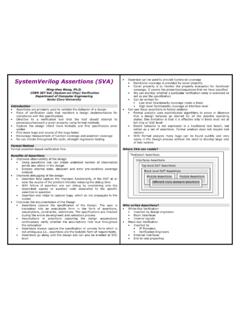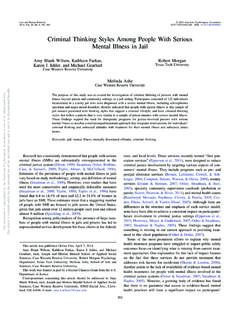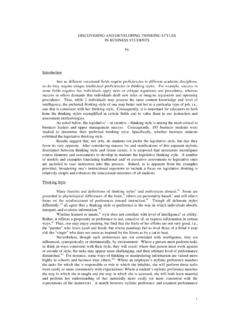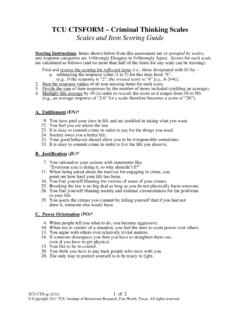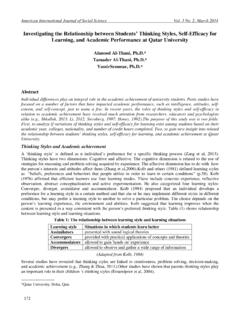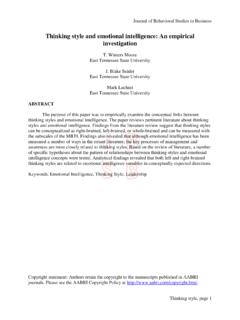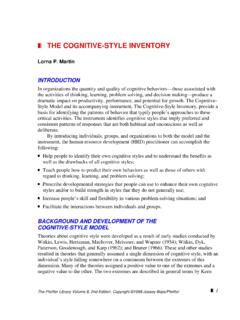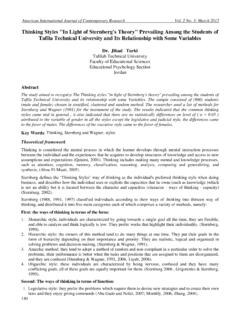Transcription of “I Think I am, Therefore ……” An Inquiry into the Thinking ...
1 I Think I am, Therefore .. An Inquiry into the Thinking styles of IT Executivesand ProfessionalsAbstractThis paper reports the results of a study of the Thinking styles of mid-level and senior informationtechnology (IT) executives from the United States. Contrary to popular belief, this populationscores significantly lower than would be expected in the analyst Thinking style and significantly higher than would be expected in the holistic or idealist Thinking style. We proceed to argue that thismisperception is gravely prejudicial to the career interests of the ITexecutives and limits the contribution that they can make to the corporation as a whole. Tocorrect the misperception, we prescribe three major strategies that IT executives can use, andalso, discuss how IT executives can use knowledge of others Thinking styles to be more influential and IntroductionFor years, IT organizations have struggled to achieve the respect that many IT executives believethey so rightfully deserve.
2 Many reasons have been put forth for the poor reputation and lack ofrespect for the IT function: failure to deliver, poor marketing and poor customer relation skillsare just some that are mentioned. We believe another prominent reason is that ITexecutives arenot viewed as peers by the rest of the senior management team. Rather, they are seen as narrow,technical, analytical individuals. Research that we have just conducted reveals that this is amisperception. Indeed, our research shows that ITexecutives have the very Thinking styles thatCEOs have told us they would like to see in a senior executive, and specifically, in their years ago, the authorsand a colleagueinterviewed a number of CEOs and asked themwhat IT organizations needed to do to be successful[DeLisi, Danielson, and Posner 1998]. Thisresearch highlighted the fact thatthese CEOs feltIT executives did not have the skills theyneeded to be successful in their jobs. Prominent among these were interpersonal and an attempt to rectify these deficiencies, wedevelopedthe Information Technology LeadershipProgram (ITLP) at Santa Clara University.
3 This intensive three-day program focuses on theexecutive and general management skills that CEOs had told us IT executives needed to one portion of ITLP, we introduce the participants to the subject of Thinking styles , noting thatthe way we Think is instrumentalnot onlyin how we make decisions, but alsoinhow we relate toothers. Weadministerthe Inquiry Mode Questionnaire (InQ) [InQ Educational Materials 2001]toassess howeach of five different Thinking types:synthesist, idealist, pragmatist, analyst and willdescribe these in more detaillater but it is fair to statefor nowthat the pragmatist,analyst and realiststyles match theconventional stereotypessuggested by the titles. Thesynthesist, on the other hand, represents a divergent style of Thinking , able to reconcile patternsof thought which might be contradictory for others. The synthesist does not see these items asdisconnected-rather, somehow related. Synthesists tend to be highly creative people, but canappear to be off the wall to others.
4 They represent a very small percentage of the idealist isaclassical systems thinker, seeingparts in relationship to a with ends, goals and values,need to see the "big picture," andaren t necessarilyconcernedabout the attending we began the ITLP workshops, and began using the InQ, we believed that IT professionalswere mostly analytical people. This perception was shared by the CEOs we had interviewed and,in fact, has been that of virtually all the participants in the , as we beganrecording the Thinking styles preferred by the individuals to whom we administered the InQ (over300 IT managers and professionals) we were surprised. The results indicate that IT professionalsare predominantly idealisticand pragmatic not analytical. In fact,moreIT professionalsusetheidealisticand pragmaticthinkingstylesthanwould be expected in a random sample ofthegeneral population,andfewer use theanalyticalstyle. These arereally surprising and counter-intuitive , we will seek to understand the implications of IT professionals being seen thereproblems that this causes, and,ifso, what can IT professionals do to correctthe situation?
5 We willalsoexplorewhetherthe idealisticand pragmaticthinking styles arefavorable onesfor IT professionals, and, if so, how IT professionalsmighttake advantage we answer these questions, however, we will take a more in-depth look at the results ofthe CEO study, and investigate previous research that has examined the relationship between ITprofessionals' Thinking styles and their ability to perform in their job. In addition, we willexamine trends in the marketplace and ask what the times suggest in terms of the value ofrespective Thinking styles . We will also spend additional time on study methodology, furtherclarification of the Thinking styles instrument, Characteristics ofIT ProfessionalsStereotypical perceptions of IT professionals characterize them as introverted, analytical anddetail-oriented individuals, a view that frequently surfaces in presentations and the trade press[Hildebrand 1995]. Certainly the professional training that ITprofessionalsreceive focuses onanalytic skills, and the work of developing and debugging code requires great attention to studies of computer professionals using the Myers-Briggs Type Indicator [Buie1988; Lyons 1985] suggest that the subjects are typically introvert, intuitive, Thinking types(ISTJ, INTP, and INTJ).
6 Myers-Briggs theory [Myers and Myers 1980] claims individuals withsuch types are analytical and impersonal, emphasize logic, analysis and decisiveness, are conspicuousfor patient and willing application to detail, and are determined to the point of stubborness. That is, the stereotype is studies focused on the lower ranks of the IT organization, but similar characteristics havebeen reported for senior IT managers. In reporting on a survey of IS leadership in more than 60organizations, Earl and Feeny [Earl and Feeny, 1994] report that psychometric data showsuccessful CIOs are strongly goal oriented, demonstrate stamina and steely determination inpursuit of goals, and have a strong IT background in systems analysis and , et. al., [Couger 1979] surveyed more than 800 mid-and high-level MIS managers andfound they had very low need for social interaction (lower level MIS personnel had even lowerneed). Such motivations are consistent with an introverted orientation and ability to focus our previous study of high-tech CEOs perceptions of the senior IT executive within their companies [Delisi, Danielson, and Posner 1998] we discovered that the CEOs greatly valued thecontributions of IT to the success of their companies but were generally disappointed with theabilities of senior IT CEOs believed a CIO needed essentially the same set ofskills tosucceed in his or her positionas did a CEO: General management an understanding of the business as well as the company s markets; organizational development abilities; and a broad background in various facets of activitiesessential to the company's success.
7 Strategic sense-a "big picture" view of the organization; the ability to synthesize; and theability to take calculated risks. Interpersonal skills communication; education; salesmanship; recruiting/hiring/nurturingstaff; executives were unanimous in their belief that the senior IT executives with whom they hadpersonal experience, and IT executives in general, were lacking in these skills. This observationwas in spite of the fact that the CEOs believed that IT executives have great opportunity to gain abroad understanding of the business because of the pervasiveness of IT within the CEOs were especially critical of IT executives abilities to develop a big picture view of the organization and their excessive dependence on detailed analysis. As one noted, I see the traditional MIS person getting lost in the forest of technical stuff .. we seem to immediately jump down to the smallest technical things. The CEOs in our study clearly underscored the importance of synthesis and a big picture perspective to not only the CEO job but, also, to the job of the IT executive.
8 It is important toclarify here that the CEOs use of the word synthesis is not synonymous with the synthesist Thinking style evaluated through the InQ. When the CEOs referred to synthesis, they were describing the ability to look across the pieces of the problem and to recognize the underlyingpattern. For them, as for us, synthesis is opposed to getting lost in the details. The InQ thinkingstyle most closely related to the executives use of the term synthesis is The InQ InstrumentThe InQ instrument is a product of InQ Educational Materials, Inc., and was originallydeveloped by Allen Harrison and Robert Bramson[1984]. Itis one of a number of instrumentsthat measure individual Thinking styles and related InQ is grounded in a rich philosophical tradition. Most recently, it builds upon the work ofChurchman[1971]who identified five traditions of inquirybasic to Western philosophy,corresponding to the philosophical approaches ofHegel, Kant, Singer, Leibniz and could also say that the InQ owes some of its origins to Carl Jung who,in describing thedispute between Freud and Adler,made the following comment.
9 But how comes it that each investigator sees only one side, and why does eachmaintainthat he has the only valid view? It must come from the fact that, owing to hispsychological peculiarity, each investigator most readily sees that factor in the neurosisthat corresponds to his own peculiarity. (Jung, quoted in Singer, 1972, )This "readiness to see according to one's own peculiarity" is really the basis of the theoreticalwork on the InQ and related instruments, such as the Myers-Briggs[Myers and Myers 1980]andtheHerman Brain Dominance[Herman 1995].We chose to use the InQ instead of the other related instruments for two reasons. First, the InQlooks at how people process information somethingto whichIT professionals can easily , itstays away from personality measurements, such as introversionorextraversion,therebyavoidi ngthe defensiveness that might result from a discussion of one's previously mentioned, the InQ assesses five different Thinking styles synthesist, idealist,pragmatist, analyst and are integrators.
10 They delight in finding relationships in things which, to others, haveno apparent connection. In a group discussion, they are likely to championan opposite point ofview, and are Therefore valuable in avoiding "group Think ." Synthesists tend to be highly creativepeople, very interested in change and highly speculative. To others, they may appearargumentative at times, and their pattern of thought may appear somewhat take a broad, holistic view of things, tending to be future-oriented and to Think aboutgoals. They are also interested in social values. We could say that they are "big picture" , theytend not to like have a bias for action. They like to get things done and their approach is oftenflexible and adaptive. The model of the pragmatist is, "whatever works." Unlike idealists, theirsolutions do not have to be the most tend to be logical, structured and prescriptive. They prefer predictability and rationality,and will look for a method, a formula, or procedure to solve a particular problem.

